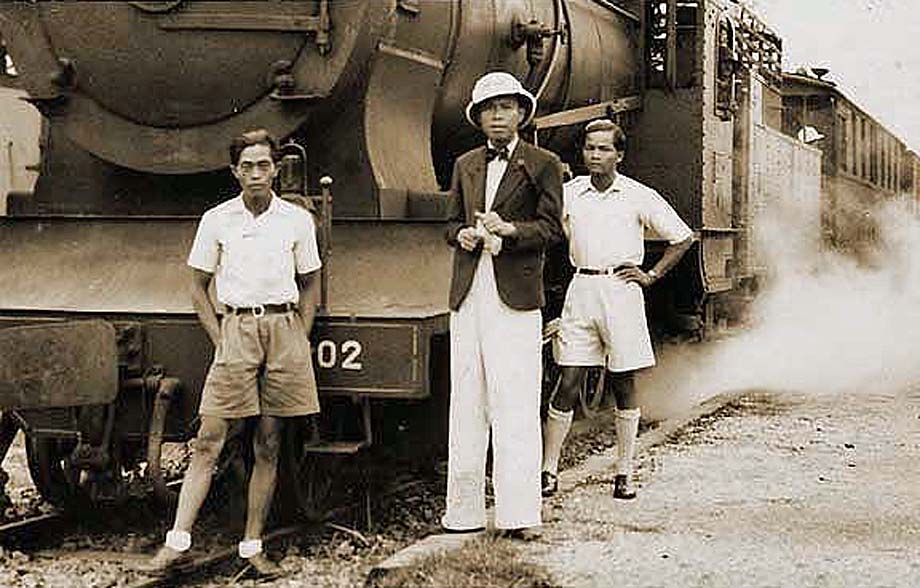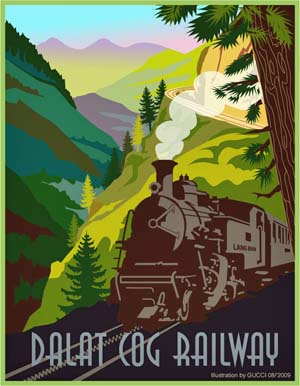
Most people know that Dalat has the most beautiful train station in Southeast Asia (with the trait of Art-Deco style in architectural structure), but not many realize that it once had one of a few unique cog railways in the world.

Let's check out how the French built that railroad in the early 20th century.
In 1903, the French built a railway that connected the cool, high, city of Da Lat with the hot, low-lying, coastal area of Phan Rang so French people could conveniently live and work for periods of time in the cool city of Da Lat.
The 84 kilometre long Da Lat-Thap Cham route (Lang Biang Cog Railway) included the 41 kilometre long Thap Cham-Krong Pha section which opened in 1919, and a 43 kilometre long Krong Pha-Da Lat section which opened in 1932, the latter of which is sloping and has cog rails in three different places with five tunnels.
Lang Biang Cog Railway Chronology
- 1903 started initial 41 Km of construction;
- 1913 completed Thap Cham to Tan My;
- 1919 completed from Tan My to Song Pha (other names Krong Pha and Bellevue);
- 1928 completed from Song Pha to Eo Gio;
- 1929 completed from Eo Gio to Don Duong (other name Dran);
- 1930 completed from Don Duong to Tram Hanh (other name Arbre Broye);
- 1932 completed from Tram Hanh to Da Lat.
Total length, 84 kilometres from Thap Cham to Da Lat.
In 1932, two French architects, Moncet and Reveron, designed the Da Lat railway station and hired Vietnamese companies to build this station about two kilometers from Xuan Huong Lake in Da Lat.
The station's design was distinctly western, but also has some characteristics of a Cao Nguyen (Central Highland) communal house with its high, steep, roof.
The station is divided into three areas, each of a good size with stained glass windows and arched ceilings.
The whole network of railways in French colonial Indochina was built by Francem and was referred to as CFI (Chemins de Fer de l'Indochine).
For convenience let's use CFI as the official French entity in this article.
After the Lang Biang Cog Railway was opened, cogwheel locomotives were imported into Vietnam in two phrases.
In the first phrase, CFI bought a total of 7 locomotives type HG 4/4, 5 locomotives in 1924, made by (Schweizerische Lokomotiv und Maschinenfabrik - Swiss Locomotive and Machineworks) and 2 HG 4/4 locomotives numbers CFI 40-306 and CFI 40-307 built and paid for by Germany as World War I reparations.
When operating between 1924 and 1929, the locomotives bore serial numbers in sequence from CFI 40-301 to CFI 40-307.
In the second phrase, between 1930-1947, CFI acquired 6 locomotives, 2 HG 4/4 locomotives serial numbers CFI 40-308 and CFI 40-309 from SLM in 1930, and 4 HG 3/4 locomotives serial numbers CFI 31-201 through 31-204 in 1947 from the Furka Oberalp Bahn in Switzerland, which had completed electrification of its railway in 1941.
During the Japanese occupation of Indochina, CFI lost 3 locomotives type HG 4/4 without a trace of any records.
The remaining engines were transferred to Vietnam Hoa Xa (VHX) after the French pulled out of Vietnam.
The numbers of all locomotives remained the same, but different the letter code became VHX instead of CFI.
In classic technology, steam engines are fueled by coal, creating steam that is converted into a pulling power of 600-820 CV (Chevaux-Vapeur).
Due to the Viet Cong's constant sabotage and mining the trains hauled their last passengers in 1968 then ceased operation of the Thap Cham to Da Lat route shortly afterwards.
It took the French 29 years of great effort to build such an extraordinary cog railway in Indochina.
Let's see how the Hanoi propagandists distorted the history of the Lang Biang Cog Railway and blamed someone else for the destruction of that historic cog railway in just one year, 1976:
"Da Lat was built in 1907. The Krong Pha train station and a nearby black iron bridge are vestiges of the French presence in Vietnam. The French intended to build a railway from Da Lat to the coastal city of Phan Rang (Thap Cham)). The train would have climbed through the most beautiful mountain passes in Vietnam, the Dran Pass and the Krong Pha Pass, also known to the French as Bellevue Pass. The Krong Pha railway, one of only two cog railways in the world, was unfinished after the French withdrawal. Many traces of it, however, can be still be found close to the road."
Source - Thanh Nien Online - 31 Mar 2008 (Thanh Nien was, now defunct, a Ho Chi Minh City-based newspaper in Vietnam. It was the second most circulated newspaper in Vietnam in 2009.)
And how they blamed the destruction of the cog railway on "American Imperialists" during the war:
"As soon as the station went into use in 1936, trains with brand new Japanese locomotives carried passengers and freight along three routes, Thap Cham-Da Lat, Nha Trang-Thap Cham-Da Lat, and Saigon-Thap Cham-Da Lat. The station had three Japanese made steam locomotives. The steam engines were fueled by wood, bringing the temperature up to boil water (12 cubic meters of water were carried), creating steam that was converted into a pulling power of 700 tonnes. Due to American bombing, the trains hauled their last passenger in 1972 and ceased operations completely. Some 20 years ago, two of the three steam locomotives were sold and now can be seen at a train museum in Switzerland."
Actually those "Japanese" locomotives were functionally restored and currently serve on Switzerland's DFB (Dampfbahn Furka-Bergstrecke).
Note: Their web page has been deleted as the information in that article was totally incorrect.
It should be mentioned that after having taken over South Vietnam in 1975, the Hanoi regime developed the Thong Nhat route railway between Saigon and Hanoi.
Lacking rail for the tracks, the idiot Commies assumed they could solve the rail shortage by disassembling the tracks of the Song Pha-Da Lat section then add them where the Thong Nhat route needed rail.
This was not only a great mistake but it also showed how dumb the Vietnamese Communists were.
Because those rails of the Song Pha-Da Lat section were special custom made for the Lang Biang Cog Railway with a great deal of technicality designed for that specific steep terrain.
To be able to endure tremendous tress caused by the train in climbing up hill, and for long life, the bearing rails themselves were made of pure, highest quality steel.
Even the nuts and bolts were different from regular rails.
So guess what, those special rails didn't match up when they were connected to the regular rails of the flat coastal railway.
They ended up as scrap metal, being dumped at some depot where thieves sawed off pieces and stole, corrupt Viet Cong officials also sold them cheap as junk yard scrap.
What a tragedy for Indochina's railway history!
If that railway had not been dismantled, today it would have been restored easily for great tours from the coastal resorts of Nha Trang, Ninh Chu, and Mui Ne to Da Lat.
The Lang Biang Cog Railway contained breath-taking scenery of Southeast Asia, especially with classic steam locomotives hauling passenger cars along the narrow ledges of the pine-forest mountains.
As the train would climb Bellevue Pass travelers could marvel at one side the slope of a green mountain, on the other, an open space stretching to the Pacific Ocean.
The scenery would change magnificently along the terrain as the train entered the misty, salubrious, Lang Biang plateau, where one would start smelling the fragrance of pine forest blended with the wood-burned scent which billowed from the locomotive's smokestack.
What a unique, unforgettable, natural scent!
When I was a kid, I had a chance to traveling by train from Saigon to Da Lat in a sleeping car, and a couple of times between Don Duong and Da Lat free of charge.
How did I get that privilege?
In the photo at the start of this article, the guy wearing the colonial hat with the command-cane under his arm is my father.
Today, there is no way to rebuild that Lang Biang Cog Railway, especially under the corrupt Communist regime.
It's irreversible since the destruction of that railway has been done.
It took the French 29 years to build that 84 kilometre Thap Cham-Da Lat railway, but after 1975 in a time of peace, it took the Viet Cong a much shorter time to "clean up" that beautiful railroad without a trace.
Even the historical steel bridge at Don Duong (Dran) was gone for scrap metal by 2004.
After a long abandoned period, grass and vegetation have now covered most of the dirt path of the old tracks, but on windy days, old folk of the Lang Biang plateau can still hear from the pine valleys the melancholic train whistles that seem to echo from lost nostalgia.
VNAF Pilot.
 The orginal article was corrected for grammar and various Vietnamese names while Latin accent characters were removed.
The orginal article was corrected for grammar and various Vietnamese names while Latin accent characters were removed.(likely no image with original article)
(usually because it's been seen before)
provisions in Section 29 of the
Canadian Copyright Modernization Act.

